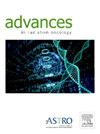Validation of a Novel Data-Driven Algorithm to Detect Atypical Prescriptions in Radiation Therapy
IF 2.7
Q3 ONCOLOGY
引用次数: 0
Abstract
Purpose
Erroneous radiation therapy (RT) prescriptions (Rx) can lead to injury or death of patients. A novel data-driven model that uses similarity learning to identify atypical Rx was recently published. In that study, prototype analysis was conducted within a single institution with a single treatment site. The present study sets out to validate the robustness of the model by applying the model to multiple disease sites using a different institution’s data.
Methods and Materials
A query was conducted of Brown University Health RT treatment records for thoracic and brain cancer patients from 1995 to 2021 to create historical databases used for training. The query included records containing data on the Rx and patient-specific features. Simulated anomalies were created to mimic potential errors and were used in the training and testing of the model. Model performance was evaluated using F1 score.
Results
F1 scores for the brain site are 99% for intensity modulated RT, 90% for stereotactic radiation therapy/ radiosurgery/SRT, and 94% for 3-dimensional RT. F1 scores for the thoracic site are 95%, 90%, and 95% for the 3 techniques, respectively. Statistical analysis shows no significant differences between the model’s prediction and ground truth.
Conclusions
The model performance shows feasibility for application to various disease sites across different institutions. This model can be used alongside physicians and physicists during peer review chart rounds to aid in the detection of potential RT Rx errors.
一种新的数据驱动算法在放射治疗中检测非典型处方的验证
目的错误的放射治疗(RT)处方(Rx)可导致患者受伤或死亡。最近发表了一种新的数据驱动模型,该模型使用相似性学习来识别非典型Rx。在该研究中,原型分析是在一个单一的治疗场所进行的。本研究旨在通过使用不同机构的数据将该模型应用于多个疾病位点来验证该模型的稳健性。方法与材料对布朗大学1995年至2021年收治的胸癌和脑癌患者的RT治疗记录进行查询,建立用于培训的历史数据库。该查询包括包含Rx数据和患者特定功能的记录。模拟异常被创建来模拟潜在的错误,并用于模型的训练和测试。采用F1评分评价模型性能。结果调强放疗的脑区F1评分为99%,立体定向放疗/放射外科/SRT的F1评分为90%,三维放疗的F1评分为94%。三种技术的胸区F1评分分别为95%、90%和95%。统计分析表明,模型预测结果与实际情况无显著差异。结论该模型可应用于不同机构的不同疾病现场。该模型可以在同行评审图表回合中与医生和物理学家一起使用,以帮助检测潜在的RT - Rx错误。
本文章由计算机程序翻译,如有差异,请以英文原文为准。
求助全文
约1分钟内获得全文
求助全文
来源期刊

Advances in Radiation Oncology
Medicine-Radiology, Nuclear Medicine and Imaging
CiteScore
4.60
自引率
4.30%
发文量
208
审稿时长
98 days
期刊介绍:
The purpose of Advances is to provide information for clinicians who use radiation therapy by publishing: Clinical trial reports and reanalyses. Basic science original reports. Manuscripts examining health services research, comparative and cost effectiveness research, and systematic reviews. Case reports documenting unusual problems and solutions. High quality multi and single institutional series, as well as other novel retrospective hypothesis generating series. Timely critical reviews on important topics in radiation oncology, such as side effects. Articles reporting the natural history of disease and patterns of failure, particularly as they relate to treatment volume delineation. Articles on safety and quality in radiation therapy. Essays on clinical experience. Articles on practice transformation in radiation oncology, in particular: Aspects of health policy that may impact the future practice of radiation oncology. How information technology, such as data analytics and systems innovations, will change radiation oncology practice. Articles on imaging as they relate to radiation therapy treatment.
 求助内容:
求助内容: 应助结果提醒方式:
应助结果提醒方式:


